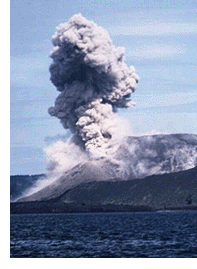

 |
Why Files staff scribe, David Tenenbaum, asked Australian zoologist Ian Thornton about the ecological lessons of the explosion at Krakatau... . Here's his response: |
 |
January 7, 1996 David, |
| 1. | An optimistic lesson: That tropical rainforest ecosystems are capable of recovery from extreme, traumatic damage, if left alone and given time. Within a century the remnant of Krakatau, Rakata, on which not a blade of grass was visible for a year, is now clothed in tropical forest from the shore to its 800-meter peak. On the three islands devastated in 1883 there are now over 400 species of vascular plants, thousands of species of arthropods including 54 species of butterflies, over 30 species of birds,18 species of land mollusks, 17 species of bats and 9 reptiles. And these components of the system have had to cross 44 kilometres of sea water to even reach the islands, never mind to become established on them.
|
| 2. | That not all components of the system build up at the same rate; some reach a plateau well before others do. |
| 3. | From comparing also the assembly process on the active volcanic island Anak Krakatau (Krakatau's Child), which emerged in 1930 from the sea in the middle of the submerged caldera resulting from Krakatau's 1883 eruption (and sterilised itself in 1952) we know that the assembly process is fairly deterministic in the early stages. That is to say that if we had several Krakatau situations, we would be able to predict which species would become established in the growing ecosystems with a fair degree of success.
This early determinism is due to the powers of |

|
 |
dispersal and the ecological attributes of the plants and animals that specialize in colonisation. For example there is a core of about 60 species of pioneer plants, mostly sea-dispersed (a few wind-dispersed), which may be expected to become established early. Later in the process the role of animals in plant dispersal becomes more important and now the process takes on a more stochastic flavour, in which chance plays a much greater role. For instance, of the three original Krakatau islands, one has a forest type with dominant tree species that are quite different from the forests on the other two islands, although they are only some three to six kilometres apart. |
| 4. | We suspect that the role of certain birds and fruit bats in dispersing the seeds of fruiting forest trees, particularly fig trees, is crucial in the build-up of mixed tropical forest.
|
| 5. | Conservation efforts need to be addressed not only to endangered species or even endangered communities or habitats, but to rare examples of important natural processes being carried out -- in this case the development of the tropical rain forest ecosystem. |
| 6. | We may have to reinstate tropical forest -- in fact Dan Janzen and his colleagues are attempting just that in Costa Rica. If we are to do this we had better learn how nature manages natural reinstatement. By manipulation of parts of the process we may be able to accelerate it or at least increase the chances of a successful outcome.
|
 |
Anak Krakatau is not the youngest volcano on the planet. That honor goes to Mexico's Paricutin, a baby volcano that offered volcanologists a chance to watch the entire life cycle of a volcano -- from corn field, to eruption, to quiescent cinder cone and part-time tourist trap. |
 |
 |
 |
 |
There are 1 2 3 4 5 6 7 8 9 10 11 documents. (Glossary | Bibliography)